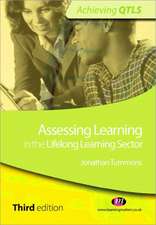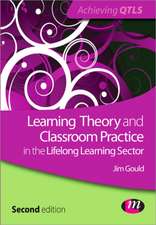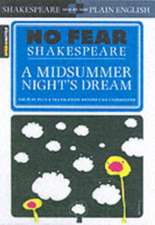Distance Learning: Principles for Effective Design, Delivery, and Evaluation
Autor Chandra Mohan Mehrotra, C . David Hollister, Lawrence McGaheyen Limba Engleză Paperback – 5 noi 2001
`Essentially this is a skill based, practical work rather than one based on theory or presenting original research. It will be useful for anyone who is considering whether or not distance learning might be of value to their institution, as well as those who are engaging in this type of provision for the first time. However, the accessible nature of this book, and the information contained within it will be a useful introductory resource for many staff in Education and Continuing Education' - Escalate
Message from authors
1. In a number of chapters, we have provided readers with Web sites which may be useful to them in obtaining additional information related to what we have covered. Since some of these Web sites may be discontinued and new ones developed, it will be beneficial to keep this information updated on a Web site to accompany the book.
2. The Web site will also be useful for providing readers with additional
information regarding the material covered in the book. For example, we may
bring to readers' attention other Web sites that offer concrete examples of
how some instructors have designed syllabi and/or assessment procedures for
their distance learning courses.
3. A related topic has to do with technology issues related to distance
learning. The Web site may suggest possible sources that would be useful to
readers in obtaining up-to-date information in this regard.
4. Readers will also appreciate learning about (a) centres of distance
learning in the United States and other countries; (b) discussion lists that would
allow them to interact with colleagues who share similar interest; and (c)
organizations involved in conducting and publishing research on various
aspects of distance learning.
In short, the Web site will be an effective and efficient way of keeping
readers informed regarding new developments related to the ever evolving
aspects of distance learning. It will be organized in terms of the topics
presented in the book and will include user-friendly commentary,
annotations, and examples.
In this book the authors lay out practical principles and advice to help individual teachers and administrators learn how to design, implement, and evaluate distance learning courses via a variety of formats. The book is a response to an explosion of interest in distance learning and increasing pressures to expand traditional on-campus courses into this realm, especially with the advent of the Internet. Such an effort requires rethinking course design, selecting appropriate modes of delivery, creating strategies to promote active learning, maintaining ongoing contact with students, and assessing learning outcomes. However, many faculty members and administrators have had limited experience designing such courses. This book shows them how.
Features/Benefits:
· Research that informs recommendations and a wealth of examples and strategies based on field-tested models, student preferences, and the authors' own extensive experiences results in advice that readers can trust.
· Comprehensive coverage addresses available delivery options (and their respective strengths and shortcomings), factors to consider in selecting a delivery mode, designing a syllabus for a distance course, fostering student learning and development, providing student support services, and assessing student performance.
· Practical matters are stressed throughout, such as attracting students, ensuring high rates of completion, conducting program evaluation, and preparing a self-study for accreditation review.
| Toate formatele și edițiile | Preț | Express |
|---|---|---|
| Paperback (1) | 718.92 lei 6-8 săpt. | |
| SAGE Publications – 5 noi 2001 | 718.92 lei 6-8 săpt. | |
| Hardback (1) | 994.85 lei 6-8 săpt. | |
| SAGE Publications – 5 noi 2001 | 994.85 lei 6-8 săpt. |
Preț: 718.92 lei
Preț vechi: 876.74 lei
-18% Nou
Puncte Express: 1078
Preț estimativ în valută:
137.57€ • 147.11$ • 114.70£
137.57€ • 147.11$ • 114.70£
Carte tipărită la comandă
Livrare economică 17 aprilie-01 mai
Preluare comenzi: 021 569.72.76
Specificații
ISBN-13: 9780761920892
ISBN-10: 0761920897
Pagini: 256
Dimensiuni: 152 x 229 x 13 mm
Greutate: 0.35 kg
Ediția:New.
Editura: SAGE Publications
Colecția Sage Publications, Inc
Locul publicării:Thousand Oaks, United States
ISBN-10: 0761920897
Pagini: 256
Dimensiuni: 152 x 229 x 13 mm
Greutate: 0.35 kg
Ediția:New.
Editura: SAGE Publications
Colecția Sage Publications, Inc
Locul publicării:Thousand Oaks, United States
Recenzii
"The overall strength of this volume is its emphasis on practical considerations that an instructor is likely to encounter in creating a distance course. . . . particularly strong in presenting easily understood principles of good practice for those who must plan and implement distance learning."
"This book is a fine example of what is needed for distance learning teachers,
administrators, and evaluators throughout the world. It provides good coverage of the timely topics that face distance educators daily. For those considering starting a distance learning course or program, this book would provide a solid footing upon which to make important decisions."
"This book is a fine example of what is needed for distance learning teachers,
administrators, and evaluators throughout the world. It provides good coverage of the timely topics that face distance educators daily. For those considering starting a distance learning course or program, this book would provide a solid footing upon which to make important decisions."
Cuprins
Acknowledgments
Introduction
Background and Audience
Overview of the Contents
Our Companion Web Site
1. Distance Education: What Is It? And Why Is It Expanding So Rapidly?
Impacts of Technology on Distance Education
The Prevalence of Distance Education in the United States
Societal Changes Contributing to the Growth of Distance Education
The Impact of Distance Education on Traditional Instruction
Criticisms of Distance Education
Conclusion
2. Attracting Students to Distance Learning
How to Assess the Need and Demand for a Distance Program
Target Audience
Instructional Design and Mode of Delivery
Strategies for Marketing Distance Courses and Programs
Specific Ideas for Promoting and Marketing Distance Programs
Conclusion
3. Good Practices in Distance Education: How to Promote Student Learning and Development
The Good Practices
Summary Tips
4. The Syllabus for Distance Learning Courses
What Is a Syllabus?
More Than a List
Outline for a Syllabus: Putting It Together
Other Issues
Summary Tips
5. Delivery Methods for Distance Education
Synchronous or Asynchronous?
Synchronous Delivery Methods
Asynchronous Delivery Methods
Conclusion
6. Selecting Delivery Methods
Fundamental Principles to Observe in Selecting Delivery Methods
A Decision Tree Approach to Selecting a Delivery Method
Conclusion
7. Support Services
Support Services Prior to Enrollment
Support Services for Enrolled Students
Support Services After Course or Program Completion
Summary
8. Ensuring High Completion Rates
The Problem of Retention
Retention in Distance Education Programs
Strategies for Improving Completion Rates
Summary Tips
9. Assessing Learning Outcomes
Guiding Principles
Methods of Assessment
Conclusion
Summary Tips
10. Program Evaluation
Evaluating Program Inputs
Program Processes
Assessing Outcomes
Analysis of Costs and Outcomes
Conclusion
Summary Tips
11. Accrditation
Guidelines for Distance Learning
Providing Evidence Regarding the Program's Effectiveness in Meeting the Guidelines
Conclusion
Summary Tips
Conclusion
Author Index
Subjedt Index
About the Authors
Introduction
Background and Audience
Overview of the Contents
Our Companion Web Site
1. Distance Education: What Is It? And Why Is It Expanding So Rapidly?
Impacts of Technology on Distance Education
The Prevalence of Distance Education in the United States
Societal Changes Contributing to the Growth of Distance Education
The Impact of Distance Education on Traditional Instruction
Criticisms of Distance Education
Conclusion
2. Attracting Students to Distance Learning
How to Assess the Need and Demand for a Distance Program
Target Audience
Instructional Design and Mode of Delivery
Strategies for Marketing Distance Courses and Programs
Specific Ideas for Promoting and Marketing Distance Programs
Conclusion
3. Good Practices in Distance Education: How to Promote Student Learning and Development
The Good Practices
Summary Tips
4. The Syllabus for Distance Learning Courses
What Is a Syllabus?
More Than a List
Outline for a Syllabus: Putting It Together
Other Issues
Summary Tips
5. Delivery Methods for Distance Education
Synchronous or Asynchronous?
Synchronous Delivery Methods
Asynchronous Delivery Methods
Conclusion
6. Selecting Delivery Methods
Fundamental Principles to Observe in Selecting Delivery Methods
A Decision Tree Approach to Selecting a Delivery Method
Conclusion
7. Support Services
Support Services Prior to Enrollment
Support Services for Enrolled Students
Support Services After Course or Program Completion
Summary
8. Ensuring High Completion Rates
The Problem of Retention
Retention in Distance Education Programs
Strategies for Improving Completion Rates
Summary Tips
9. Assessing Learning Outcomes
Guiding Principles
Methods of Assessment
Conclusion
Summary Tips
10. Program Evaluation
Evaluating Program Inputs
Program Processes
Assessing Outcomes
Analysis of Costs and Outcomes
Conclusion
Summary Tips
11. Accrditation
Guidelines for Distance Learning
Providing Evidence Regarding the Program's Effectiveness in Meeting the Guidelines
Conclusion
Summary Tips
Conclusion
Author Index
Subjedt Index
About the Authors
Notă biografică
Chandra M. Mehrotra is Professor of Psychology and Dean for Special Projects at The College of St. Scholastica in Duluth, Minnesota. He received his Ph.D. in psychology from Ohio State University. He is a fellow of the American Psychological Association and the Gerontological Society of America (GSA). He received his college¿s Distinguished Teaching Award in 1979, the APA Division 20 Mentor Award in 2003, and the GSA¿s Outstanding Mentorship Award in 2011. He directs faculty training programs in aging research with support provided by the National Institute on Aging, National Institutes of Health, and the Hartford Foundation. His books include: "Teaching and Aging" (Jossey-Bass, 1984), "Measuring up: Educational Assessment Challenges and Practices for Psychology" (APA Books, 2004), "Aging and Diversity: An Active Learning Experience (2nd Ed)" (Routledge, 2009), and "Assessing, Teaching and Learning in Psychology: Current and Future Perspectives" (Cengage, 2013). He has guest-edited two special issues of the journal "Educational Gerontology": (a) "Strengthening Gerontology and Geriatrics Education"; and (b) "Fostering Aging Research in Undergraduate Psychology Programs." His activities with Native American communities include civic engagement among elders, culturally appropriate program evaluation, intergenerational relationships, and improvement of teaching and learning in tribal colleges. He currently serves as a member of American Psychological Association¿s Committee on International Relations in Psychology and the Minnesota Board of Examiners for Nursing Home Administrators.
Descriere
What delivery methods are available to make education accessible to a wide variety of potential learners? What are their strengths and weaknesses? How can instructors create effective learning environments in distance courses? What support from administrators and staff is essential? What guidelines are used by accrediting agencies to assure program quality? This highly readable book by three experienced faculty members answers these questions and more. Both theoretical and practical, the book presents proven principles and research-based advice. Drawing upon their experience with a variety of delivery modes, the authors provide readers with tips they can use in designing, implementing, and evaluating distance courses and programs.






